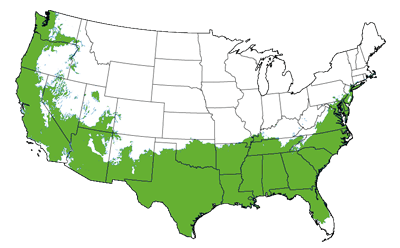Tifblue Blueberry
Product Details
 Growing Zones 7-9
Growing Zones 7-9
| Soil Type | Acidic |
| Sunlight | Full, Partial |
| Drought Tolerance | Good |
| Mature Height | 6-10 Feet |
| Mature Width | 6-10 Feet |
| Fall Color | Red |
| Bloom Color | White |
| Shipping Restriction | AZ, CA, OR, WA |
The Tifblue Blueberry is a variety from the Rabbiteye family. These blueberries are native to the Southern US and are a favorite in home gardens because of their resistance to disease and heat and drought tolerance. The Tifblue Blueberry Bush is considered “the most universally outstanding Rabbiteye blueberry” according to the Texas Agrilife Extension Service.
The Tifblue is the most cold-hardy blueberry bush in the Rabbiteye family. Reaching a height and width of 6-8 feet, it has the potential to produce a huge abundance of blueberries. White blossoms are formed in mid to late March with the promise of ripe berries in Mid-June to late July. Foliage can be characterized by a glossy green texture with a beautiful burgundy fall color. Tifblue blueberries are small to medium in size and are tart in flavor until fully ripened.
The Tifblue Blueberry bush makes a great hedge because of its astounding size. Use it for screening purposes, plant in clusters or as a single specimen in the backyard. It will be sure to bring enjoyment to all when harvest season comes along. If this bush is not compatible with your planting zone, plant it in a nice container and bring it indoors whenever weather conditions get too extreme.
Many blueberry varieties are self-fruiting; however, the Tifblue Blueberry requires cross-pollination to produce fruit. Below are some recommendations for the most effective cross-pollinators.
Blueberry Comparison Chart - Self-Fertile
Blueberry Comparison Chart - Not Self-Fertile
When planting your Tifblue Blueberry be sure to choose the right location and conditions for your new plant to thrive. Spring and Fall are ideal times to plant. However, if you avoid extreme temperatures you can plant your Blueberry almost any time of the year.
Blueberry shrubs thrive in full sun and well-drained, moist, acidic soil. If you have alkaline soil, be sure to amend your soil. To acidify your soil amend with compost, elemental sulfur, or use fertilizers specific for acid loving plants. Mulching with pine straw or pine bark will help over time as they begin to break down, but are not an immediate solution. To improve drainage in something like a heavy clay soil, add compost and be sure to loosen up the soil well before planting. Water deeply when planting and 2-3 times weekly for 3 months while your Blueberry plant is establishing. During the growing and fruiting seasons, a blueberry will do best if the soil is kept moist. Adding a layer of 2 to 3 inches of mulch is highly recommended for Blueberry bushes. Mulching helps to maintain soil moisture and gives added protection during extreme temperatures. Fertilize in spring with a balanced, slow release fertilizer like 10-10-10, preferably for acid loving plants. Bluberries grown in containers will need fertilized 3 or 4 times per year during the growing season as nutrients leech out of the pot when you water. Prune your Blueberries in late winter to remove any dead, dying, or crowded branches and to maintain size. The Tifblue variety requires a pollinator, like Brightwell, to produce a good crop of berries.
The best way to prevent disease and pests is by providing the appropriate care for your plants. Proper location choice, watering, and fertilization are the keys to your success. The biggest pests of blueberries is birds. You can put up bird netting to protect your crop. If positioned properly, this is an extemely effective deterrent. Most insect pests feed on the leaves of blueberries. You can treat most of these pests naturally with horticultural oil, neem oil, or insecticidal soap. Blueberry Bushes can occasionally encounter fungal issues. Generally, treating after infection isn't extremely effective, so if you have problems yearly treat in early spring with fungicides to prevent infection. Neem Oil is an organic method of treating and preventing some fungal diseases and pests. The entire shrub must be coated in order for this method to be effective.
Learn when to prune your flowering shrubs.
For additional options, be sure to browse our Blueberry Bushes, Dwarf Tree and Fruit Trees collections.
















